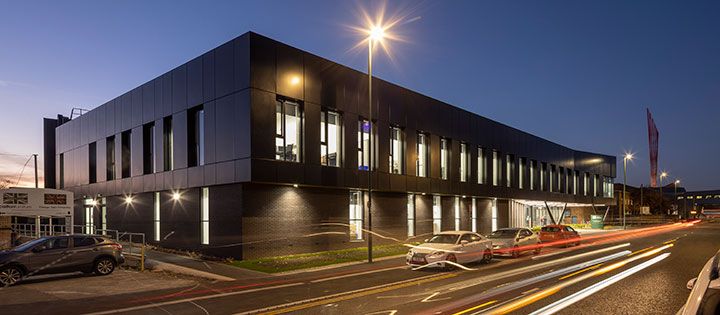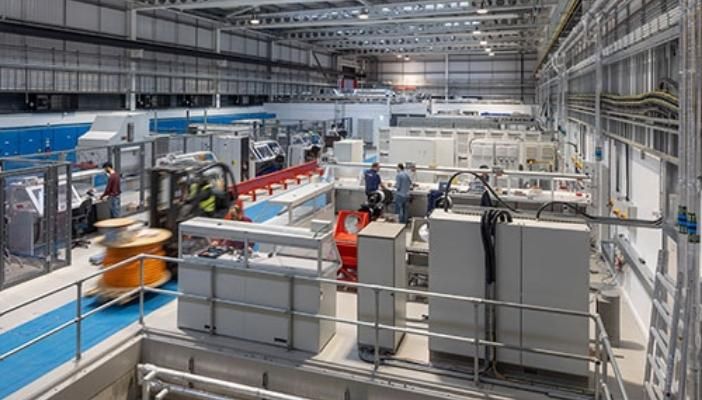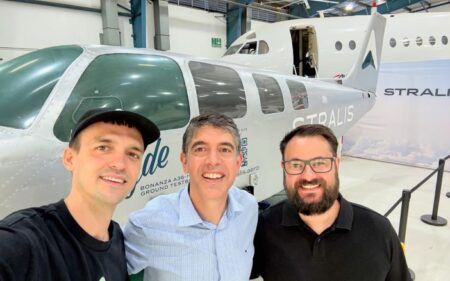A research facility at the University of Nottingham that was officially opened last week has already begun work advancing aircraft electrification technology.
The £40 million (US$50 million) Power Electronics and Machines Centre (PEMC) offers purpose-built laboratories for the Power Electronics, Machines and Control research group, the largest such group of researchers in the world. It hosts the UK Government-funded Driving the Electric Revolution Industrialisation Centre – Midlands (DER Midlands Industrial Center) which is developing technology and manufacturing processes for advanced electrical machines and drives.
The building also houses the 20MW UK Electrification of Aerospace Propulsion Facility (UKEAPF) which will offer large-scale industry testing, the likes of which “no other research institute in the world can offer,” said Sam Kingman, Professor and pro-vice chancellor for Faculty of Engineering.
“The creation of our new Power Electronics and Machines Centre is truly game-changing when it comes to the future of transportation electrification, including the aviation and automotive sectors. We’re using our testbeds to look 10 years or more into the future, trying to solve the problems industry doesn’t know they’ve got yet while also working closely with industry to understand and help solve their needs for today,” added Kingman.
Construction of the PEMC cost £18 million (US$22 million) with planning started in 2014. Around £18 million has been invested in new equipment and an additional £18 million in industry support is forthcoming.
The current research portfolio in PEMC is worth over £35 million (US$42 million).
Professor Shearer West, vice-chancellor of the University of Nottingham said, “By March 2024, we estimate that £470 million [US$575 million] worth of industrial work will align with the PEMC facility, and with the support of partners our ambition is to make the East Midlands the world’s foremost location for low-carbon aerospace innovation.”
“I think it’s fair to say over the next few years we are probably spending £40 million on capital and £40 million on activity,” said Chris Gerada, associate pro-vice-chancellor industrial strategy, business engagement and impact at the University of Nottingham. “In the facility, to be clear, there are no students. It is an R&D facility.”

Propulsion testing
The PEMC group consists of of 170 researchers. Around 80% of research funds in the group are related to or directly from industry and aerospace applications make up the largest proportion of research on high power density motors and power electronics.
The PEMC group is also focused on the development of electrification standards and technology roadmaps for zero-emissions flight for regional aircraft.
The facility aims to enable researchers to put technology through rigorous test regimes and works with the automotive, rail, marine and aerospace sectors.
Pat Wheeler, head of the PEMC research group at the University of Nottingham said, “We have the scale in terms of the number of people and now in terms of the facility to test at final power levels.
“The idea of testing propulsion motors for aircraft at the level they’re going to be used on an aircraft in a university lab is unique.”
Freedom to innovate
Currently confirmed test rigs in the PEMC include a fully instrumented, 2MW 30,000rpm dynamometer test stand for e-motors and generators for hybrid electric propulsion systems and an environmental testing facility that can replicate different environments including high altitudes up to 20MW.
“We also have test facilities going right down to a few kilowatts,” said Wheeler. “It’s always the big motor testing that gets the headlines, but it’s everything behind that which allows you to make powertrains much smaller, lighter and then demonstrate them that is the really amazing part of the facility.”
Beside the physical test rigs themselves, one of the PEMC’s strengths is in its focus on technology, not product. “We’re free of having to develop product, our role is in the knowledge base,” said Wheeler.
“We’re not trying to develop tomorrow’s product. We’re looking ten, fifteen, twenty years ahead to what that industry is going to need.”
Gerada said, “It would be difficult to make a business case as a company to develop technologies that are 10 years away, this facility enables that. It’s really a valuable asset to accelerate technology into deployment.”
Free from the constraints of in-house commercial proposals, the PEMC stands alone as “a university or technology institute which is open access, certainly unique in terms of an R&D development,” Gerada added.

Decarbonization goals
Even with governmental and industry backing there is a long road ahead as the aviation sector decarbonizes on a global scale, with power density requirements, partial discharge issues, safety requirements and questions of efficiency still pressing concerns for the future of aircraft electrification.
“With aerospace, there’s a big challenge in terms of getting the right electrification technologies deployed, whether it’s power density, reliability, efficiency and so on. Proving and validating them is not an easy task and it’s a very expensive thing to do,” said Gerada, whereas the technology for electric land vehicles is “there and it’s more about how you can get the right supply chains, make sure it’s cost-effective.”
Nonetheless, there is great hope for the future of the PEMC and for ongoing decarbonization efforts across all transport sectors. “The basic technology and understanding that we develop translates very well between the sectors, it’s how you use that information,” said Wheeler.
“The science behind that is a fundamental understanding of why it breaks and how it’s going to fail. If you have that understanding then different industries can use that understanding in the way they need.”





